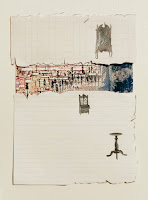Most artists work in relative isolation. Our collective art practices and the creative process demands it. It goes against the human urge to congregate and socialize. Still, we persevere as the 'call to create' nudges us. We then deliberately make space - intellectually, emotionally and physically. We move forward quietly, with the intention and faith in the process.
Never have we been more aware of isolation than time spent in this Corona Virus pandemic environment. It is not our choice, but as artists we are familiar and in some ways ahead of the game over our fellow citizens by our familiarity and relative comfort with the loneliness of self -containment.
London artist Neha Chandaria uses time in isolation to experiment with digital installations.
Before the pandemic:
 |
| Untitled gouache on paper 7" x 5.5" 2019 |
During the Pandemic:
 |
| Cabinet Views 3 Digital Installation mixed media 19" x 27" 2020 |
 |
| Cabinet Views 2 Digital Installation mixed media 17" x 17" 2020 |
 |
| Untitled pencil and collage,writing paper 11"x 7.5" 2020 |
 |
| Untitled pencil and collage on fragments of writing paper 7.5" x 5" 2020 |
1) How has your work shifted during the pandemic?
Has it been a change in the process of you creating art? The mediums
you use? The themes or concepts you are thinking about?
My artworks over the years has had a very slow and gradual change. I have a low appetite to explore or add new motifs into my works. I like to explore/repeat motifs or similar motifs in my works and time during this Pandemic is no different. During the Pandemic I've been interested in exploring cabinet spaces- to display or make artworks in relation to these furniture spaces; somehow all this is influenced by confinement inside my home for months now.
I've made a few works titled Cabinet Views, where I used photographs and a digital medium to create a dialogue with the inside of the cabinets and the objects in it. Sharing images of the same, hoping to take these formative experiments to the next level.
In terms of the medium, I am also thinking of exploring felting medium.
2) What have you discovered about yourself as an artist during this pandemic?
I really liked the home-studio concept. During the pandemic I saw new possibilities of creating a dialogue with one’s immediate surrounding especially at home. During this time, more than creating artworks or final products, I enjoy reading about art, looking at art, contemplating art, writing about artworks, etc.
3) What have been your biggest challenges working in isolation? Surprises?
During the Pandemic I began working on lined writing paper, with motifs rendered as text in a pencil medium.
I can’t think of any challenges as such, but I miss my community art practice and the art room in London where I teach art to children.
The major challenge was that due to the pandemic, a group show including my work in London was shelved and postponed.








